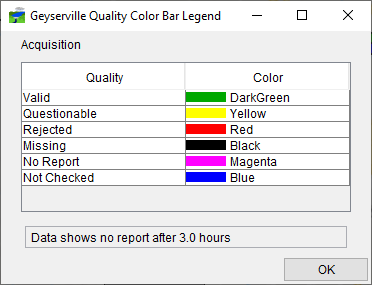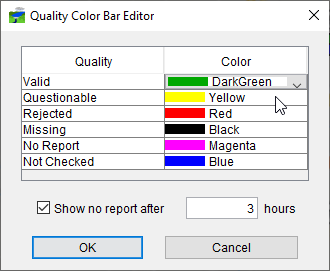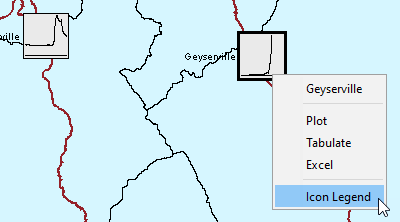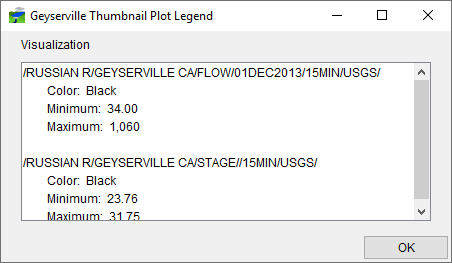Reviewing Data Quality
Reviewing the quality of the data is the primary task during the HEC-RTS data acquisition process. There are four primary ways to assess the quality of data, to identify specific locations with data issues.
- Use of quality color bars and thumbnail plots. HEC-RTS can display time series icons as quality color bars or thumbnail plots representing gages where data has been collected. Quality color bars are color coded according to the quality of data at a location. This allows you a quick visual overview of data that has been acquired in the watershed for the specified time window.
- Use of plots and tabular data. When you have identified locations where issues exist, plots and tables provide detailed views of data, helping you determine the nature of the issue.
- Use of Data Summary Lists. Data summary lists allow you to view gages in groups (such as all precipitation or all flow gages) and see details for more or fewer gages than display in the geo-referenced map window (Data Status Lists).
Quality Color Bars
Quality color bars (Figure 1) offer a quick overview of acquired data in the watershed, reflecting the status of data at each location as being acceptable, missing, or questionable.
HEC-RTS attaches quality flags to the data based upon thresholds that have been set.
A quality color bar (Figure 1) is a thick, segmented line representing the history of the data quality at a specific location within the time window you have established. The name of the location appears adjacent to the color bar, and the length of the color bar represents a timeline equal to the duration of the time window. Segments along the color bar reflect time intervals, with colors corresponding to the data quality legend you have defined. The quality color bars are updated dynamically at the time interval that you entered in the Time Window. As part of your daily routine, you should review quality color bars to determine if data is good and which data needs to be validated. To view the legend for quality color bars:
- Right-click on a time series icon in the Map Window, from the shortcut menu, click Icon Legend, the Quality Color Bar Legend dialog (Figure 2) will open.
- The legend displays the quality flags for the data and the colors that represent each quality flag. You can change the color associated with the quality flags.
- From the HEC-RTS main window, from the Acquisition tab, from the Edit menu, click Icon Quality Colors, the Quality Color Bar Editor (Figure 3) will open.


- To change the color of a quality flag, in the Color column of the table click the drop-down list and a list of available colors appears.
- Click the color you wish to change, and the color appears in the cell of the Color column.
- The Show no report after flag (Figure 3) is a quality check for irregular time series datasets only and is not used in HEC-RTS.
- Click OK, the Quality Color Bar Editor (Figure 3) closes, and the Map Window refreshes all quality color bars.
Thumbnail Plots
In some cases, you may wish to use thumbnail plots to represent gages and time series locations. Thumbnail plots (Figure 4) provide a miniature version of the full-size plots available in HEC-RTS, displaying data for the time window. The name of the location appears adjacent to the thumbnail plot. As the time window updates, HEC-RTS refreshes the data and updates the thumbnail plot. The thumbnail plots are updated dynamically at the time interval that you entered in the Time Window.

To view the legend for thumbnail plots:
- From the Map Window, right-click a thumbnail plot, from the shortcut menu (Figure 4), click Icon Legend. The Thumbnail Plot Legend dialog (Figure 5) will open.

- The legend displays the pathname, the color of the curve, and the minimum and maximum values of the curve. The Thumbnail Plot Legend dialog (Figure 5) provides you with information, to edit the color of the curve shown in the thumbnail plot (Time Series Icons).